The internet has a lot to answer for in respect of the sheer number of inane lists. After much thought, we have decided to contribute to the problem.
Every comic book commentator and debutante has an opinion on this subject, it seems. There are many lists of American comic book villains filled with obvious names but in different orders. Darkseid, Dark Phoenix, Deathstroke, the Joker / Mr Rictus, Magneto, Lex Luthor, Thanos, Shredder, the Red Skull, and on and on into predictable tedium. Obviously this collection of psychopaths, conquerors, thieves, and mercenaries all have solid histories of malevolent behaviour. But we think they are a lacklustre bunch compared to the genuine villainy of other comic book characters, where the evil is in the precision of execution, the strange motivations, or the delight.
Here is our list, set out in the traditional countdown from bad to worst. Unlike other lists, we explain what it is about the villain that justifies inclusion amongst the ranks of the depraved and amoral. The list of ten consists of those who have something interesting or unique in their fictional psychological make-up. None of the creations listed below revels in villainy simply through a desire for power or bloodlust. Each has some driver which sets them apart from the common muck of bad guys.
And we deliberately use the word “sinister” in the meaning of the Webster Dictionary: “singularly evil or productive of evil; presaging ill fortune or trouble; accompanied by or leading to disaster”.
One character which nearly made the list but which we dropped upon consideration was Amanda Waller. Waller is a notorious character often used by DC Comics and principally associated with the title Suicide Squad. Waller’s characterisation, as we noted in our celebration of the character’s 30th birthday, has been inconsistent over the years. The best version however was that fleshed out by writer John Ostrander in the early 1990s. Mr Ostrander over the period of the first modern incarnation of the Suicide Squad had Waller slowly come to accept her crimes, do time in prison, and evolve as a character. Waller started off happily capable of maiming the members of the Suicide Squad by blowing off their limbs, engaging in blackmail, and carrying out State-sponsored murder. By the end of that title, Waller is surly and irascible, but no longer callously ruthless.
One final note before we begin. The pool of characters is drawn from American comic books. But consider how many of these characters are created by Brits. Perhaps it takes an Englishman or a Scotsman to pen true evil.
10. Adrian Veidt – Watchmen 1987, and Doomsday Clock 2018-present, DC Comics.
Veidt is a mastermind who killed thousands of New Yorkers in order to save the world from nuclear destruction arising from the downwards-spiralling Cold War. Veidt, a self-made billionaire industrialist who was a masked crime fighter in the 1970s going by the name Ozymandias, is happy to manipulate the god-like Dr Manhattan in Watchmen and the mentally-deranged vigilante Rorschach in Doomsday Clock to achieve his goals.
In Watchmen, after lining up all of the pieces to destroy a chunk of New York by teleporting a genetically-engineered, fake alien monster, accompanied by a lethal telepathic blast, Veidt ensured that no one involved in or exposed to the project was left alive. All of the scientists and artists who worked on the creation of the alien were blown up in a freighter ostensibly carrying them home: a psychotic political assassin called The Comedian who stumbled across the project is beaten up by Veidt and thrown through an apartment window to his (apparent) death: Veidt’s three most trusted lieutenants are poisoned by Veidt and their bodies exposed to and obliterated by the freezing snow of the Antarctic. Only the apex of the pyramid, Veidt himself, is alive. The Soviet Union and the United States deescalate their Cold War tensions to deal with this new apparent threat of alien invasion. Armageddon is apparently averted.
Veidt is driven by a messiah complex, seeking to save humanity, at almost any cost, from atomic incineration. In Doomsday Clock, a comic we have recently reviewed, we see that Veidt ultimately failed in that task, and his version of the Earth is doomed.
We think the full extent of Veidt’s psychopathy is yet to be revealed in Doomsday Clock. Veidt’s quest to persuade Dr Manhattan to return to his home reality (a parallel universe Earth) failed when Dr Manhattan confirmed he was absorbed by his experiment on the Earth of DC Comics’ mainstream continuity. In the most recent issues of Doomsday Clock, Veidt is now turning to his fallback plan. We suspect it involves the destruction of the “superhero” Earth so that Dr Manhattan has a reason to return to the “Watchmen” Earth. Depriving Dr Manhattan of his laboratory would give him a reason to save his original planet. If this theory was true, then this would be a truly diabolical manifestation of Messianic passion.
Veidt was created by Alan Moore, a Brit.

9. Tao – W.I.L.D.Cats #21-34, 50 Image Comics, July 1995, – February 1997 and June 1998: The Sleeper, 2005-2006. Wildstorm Comics.
Mr Moore also created the character Tao, as a then-new addition to the line-up of a paramilitary superhero group called W.I.L.D.Cats. “Tao” is an acronym for “tactically enhanced organism”. Tao is a very ordinary looking man without apparent superpowers, and he relies upon his harmless appearance to sow doubt and outwit opponents. Like Veidt, Tao is ever opportunistic and is pervasively beguiling, causing one of the key characters within the team to fall in love with him as a better way of controlling not just her but the other team members. Once Tao is revealed, everyone who knows him knows to not be within earshot.

Working within the W.I.L.D.Cats, Tao’s agenda of dominion slowly emerged, with victims along the way:


In Greg Rucka’s excellent sequel to Tao’s story, called The Sleeper, Tao comes to rule a super villain deep state called the Syndicate. Tao calculates probabilities of outcomes. He is a formidable adversary gifted with irresistible charisma and intelligence. Mr Moore suggests that as a “tactically augmented organism”, Machiavellian strategy in all aspects of his existence is just what Tao is built to do.
But much of Tao’s later characterisation by Mr Rucka, is instead along the lines of the entertainment value of the contest. It evolves that Tao knows that the main character in The Sleeper, Holden, is a double agent. Tao manoeuvres Holden into a position where he had no choice but to be one of Tao’s mob bosses, and seems amused by Holden’s struggles with loyalty. Tao is a ruler in Hell, surrounded by devil-like lieutenants, some angry, some cold and cruel, all manoeuvring against each other within the pack. Only Tao seems amused by the vicious hierarchy he has constructed and surveys as each of the players goes forward exactly as predicted by Tao.
Tao is only defeated within the pages of The Sleeper when his silver tongue is ripped out of his mouth – an out-of-the-box solution not expected by him or anyone else.
Mr Moore’s unveiling of the character as the villain was masterful. Tao was an actor on the stage who seemed to be little more than scenery. Reading the story from the beginning, the reader could be forgiven for thinking that Tao was going to be the expendable “red shirted ensign” (we refer here to the plot signpost in old Star Trek television episodes, in which an anonymous red-shirted crew member was killed to underscore the threat, and which evolved into a cliche). Tao did not die the heroic death to save the team, mourned by his colleague and lover: instead, he was the ultimate menace, hiding amidst the ranks of more powerful superheroes. There is a sense of spider-like patience and calculation to Tao’s (and Mr Moore’s) planning within W.I.L.D.Cats, reinforced by Mr Rucka’s use of Tao as the principal antagonist in The Sleeper.
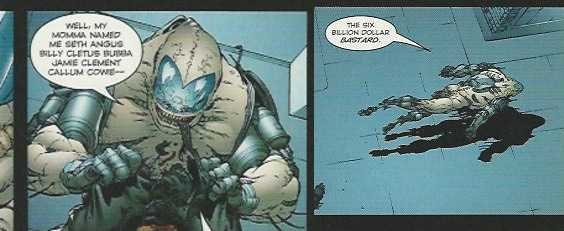
8. Three Willy Seth -The Authority #22-29, 2001-2, Wildstorm Comics.
Created by Mark Millar (a Scot), Seth Angus Billy Cletus Bubba Jamie Clement Cowie (named after every one of his possible fathers/uncles) is a genetically engineered hillbilly, by his own self-description, unleashed upon the superhero team The Authority. Seth is both immensely powerful and particularly depraved: here, he viciously attacks the unconscious and vulnerable Engineer:
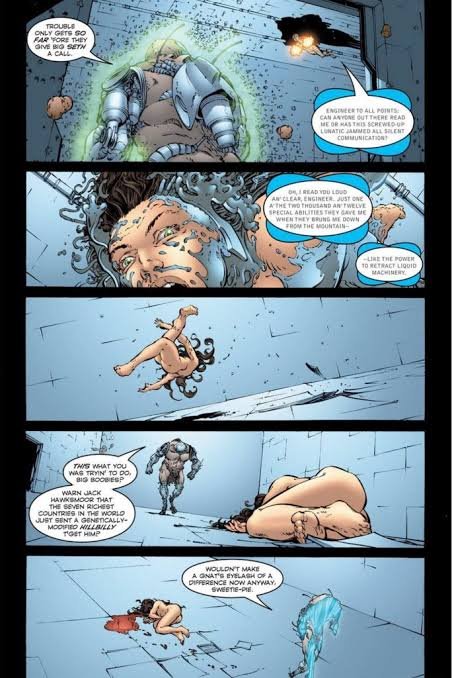
After interfering in the 1999 genocide in Timor L’Este, The Authority received a warning from then US President Bill Clinton not to interfere in the political world order. One of The Authority’s members, Jack Hawksmoor, replied with a veiled threat. Shortly thereafter, Three Willy Seth makes a surprise attack on The Authority, disposing of them in a thoroughly brutal fashion save for the ever-resourceful Midnighter.
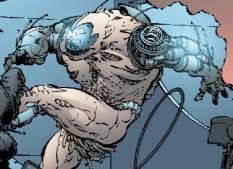
With a sexual penchant for terrified little girls, Seth was then installed in the White House as a nameless US president’s bodyguard. When the Midnighter reappeared from hiding and rescued each of The Authority’s members, Seth re-emerged and again overwhelmed The Authority. Seth was defeated when the preset code words, “Welcome to the Oval Office, President Gore” stripped him of his powers. Seth was then magically transformed by The Doctor (a member of The Authority, and Earth’s shaman) into a flock of chickens, and left to the unsavoury sexual preferences of Seth’s uncles.

Seth was a vicious, cunning, and amoral piece of filth, a child molestor, as arrogant as he is depraved. Seth’s dialogue demonstrates that he was entirely self-aware of his awfulness. Despite projecting through dialogue that he was an uneducated hillbilly, Seth was a master tactician. The attack on The Authority was well-planned and executed: Seth snuck about The Authority’s base (apparently somehow hiding in the uterus of a female pizza delivery driver), and then took out an all-powerful superhero team, who suffered from the hubris of successive victories, within the space of five minutes. He is a worthy inclusion to this list.

7. Ananke -The Wicked + The Divine, 2014- ongoing, Image Comics.
Written by Kieron Gillen (a Brit), The Wicked + The Divine examines the periodic manifestation of godly avatars. These avatars are ordinary people who unexpectedly become imbued with archetypal powers, ranging from sky gods to a goddess of the hunt, to various gods and goddess of death and the underworld. As to be expected in the 21st century and the interconnectivity of social media, they become internationally famous. We have discussed this title, and it’s messages and meaning, previously.
The villain of the piece is an immortal woman named Ananke. Ananke perpetuates her life through an horrific ritual invoking the decapitation of four of the gods and goddesses keeping their still living and animated heads in a catacomb. To prevent them from spilling Ananke’s secrets, she stitches their mouths together.

Ananke’s origins are bleak. Ananke’s sister curses her as she is murdered with a stone knife in prehistoric times.

Ananke is playing a very long game, and has no qualms whatsoever about the ongoing preservation of her existence. She has engaged in six thousand years of premeditated murder, and wants to keep travelling that bloody path into eternity. This requires an endless exercise of Machiavellian ruthlessness.

6. Mr Hyde – League of Extraordinary Gentlemen, 1999-2007, America’s Best Comics.
Mr Hyde was an introduction by Mr Moore into his mash-up of late 1800s / early 1900s fictional characters, under the title League of Extraordinary Gentlemen. Hyde is the Hyde of the book The Strange Case of Dr Jekyll and Mr Hyde, written by Robert Louis Stevenson in 1886. As Hyde notes, as he indulges more and more in his amorality, he has become bigger and stronger: his counterpart Dr Jekyll conversely became weaker and weaker, eventually disappearing from view entirely.

Hyde himself does not appear to be from this mortal realm: about to sacrifice himself, he reflects on his apparent origins from the depths below.

Despite his appearance as a brute, Hyde has both animal cunning and a strange sense of honour. Hyde’s enhances senses are capable of seeing one of his colleagues, the Invisible Man (of the book of the same title written by HG Wells in 1897) apparently in infra-red – Hyde can see the Invisible Man’s heat signature. But Hyde keeps this to himself. When the Invisible Man betrays humanity by selling out to Martian invaders, and attacking the team leader Mina Murray (a victim of Bram Stoker’s Dracula), Hyde extracts a horrible penalty.


Hyde rapes the Invisible Man and mutilates him to the extent that Hyde is utterly soaked in his blood. Only as the Invisible Man slowly dies of his wounds does the blood and the extent of it become visible – including, horribly, around Hyde’s mouth – to the murderous disgust of his colleague Nemo (from Jules Verne’s Twenty Thousand Leagues Under the Sea):

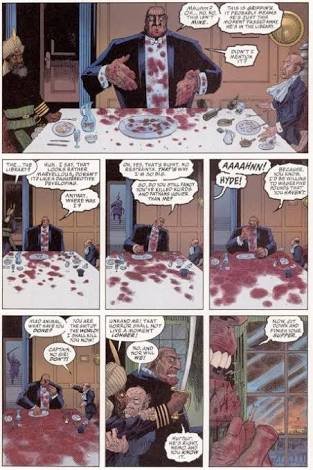
Hyde’s death in stalling the Martian invaders as they cross the Thames involves being flayed by a Martian death ray, and in retaliation cracking open a Martian tripod and eating a Martian.
Brutally sodomising a man to death, otherwise being utterly devoid of moral restraints, and possessing both animal cunning and unrelenting drive does not place Hyde in our list. It is the complicated drivers within Hyde’s psyche which cause us to question the parameters of his sinister behaviour. Is Hyde really from some lower sphere whereby bearing witness to any vulnerability is an emotional pain? Does Hyde really spy and chat to a personification of death, or is this a Hamlet-esque inner delusion? Hyde’s sociopathic behaviour suggests a need for survival at any cost, so why did he seek his own death in a Thermopylaean stand against the Martians on Waterloo Bridge? Hyde’s behaviour, both curious and reprehensible, appears to have causes we do not have the senses to perceive.
5. Lono – 100 Bullets, 1999-2009: Brother Lono, 2013, Vertigo Comics.
Created by Brian Azzarello (an American), Lono is one of a group of sentinels called the Minutemen. The Minutemen manage the murderous internecine tendencies of , a group of hereditary billionaires which secretly run the United States.
The Minutemen are composed of ruthless killers, each highly trained in marksmanship, firearms combat, and brawling. Each have their own very distinct flaws and strengths: some, including the former leader Wylie Times, are entirely likeable: Times has experienced tragedy arising from his live as an assassin.
But the one Minuteman who entirely revels in his violent life is Lono. A heavily set thug, Lono delights in causing bloody chaos and inflicting deep misery. One of our first introductions to Lono is when he rapes a woman whose boyfriend has stolen from him: Lono crushes the larynx of the man when he recovers his money.

Later, when engaged by as a “warlord” by the House de Medici, Lono tortures the head of a rogue house by stringing him upside down in chain, castrating him, and presenting the man with the heads of his murdered sons.

Lono is a pivotal figure in the furious endgame of the title. Somehow he escapes the slaughter, and in a 2014 sequel to 100 Bullets entitled Brother Lono, we find that Lono has escaped to Mexico and joined a church orphanage in an act of redemption. As the church is caught up in a gangland war, Lono finds himself drawn out of pacifist retirement from violence, and again reverts to form. Phenomenally tough, Lono is unfazed when his toenail is ripped out while being tortured: his retribution involves dismemberment, explosions, and intense violence.
At the conclusion, Lono is to be found chuffing on his signature cigar and swilling whiskey in the chair of the cartel head he has deposed. An undercover cop masquerading as a nun says to the priest who runs the orphanage, “you and the children have nothing to worryabout. And if you ever do…” “Lono,” the priest finishes the sentence for her. Lono finds a balance: he will protect the orphanage from cartels but on a basis by which he can express his sociopathic tendencies.
Lono was a polarising character within 100 Bullets, because of the perception that he was merely a vehicle for violence without much beyond that. Unlike some of the other Minutemen, we never learn Lono’s origins other than he is Hawaiian. Brother Lono adds considerable depth to the character: that somewhere within is a need to reform his ways, but that need cannot be realised because of his quintessential orientation towards brutality. Letting the cop live (but still giving her a critical abdominal injury) and keeping watch over the orphanage is as benevolent as it can ever get for Lono.
But for Brother Lono, we would not have included the character on our list, because, but for Brother Lono, Lono would just have been a vicious and deadly thug masquerading with swagger as a “warlord”. It is the failed effort at redemption and the strange balance that Lono struck within himself by the conclusion of the story that renders Lono a sinister cypher.
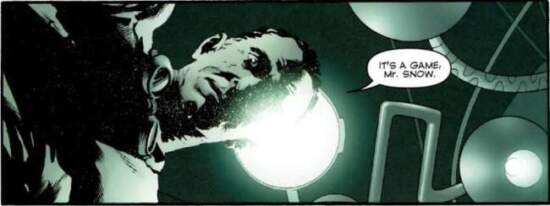
4. Randall Dowling – Planetary, 1999-2009, Wildstorm Comics.
Created by Warren Ellis (an Englishman) Dowling was the leader of a secret cabal called The Four, which in essence control the Earth. The founder of a 1950s project called Science City Zero, Dowling performed horrible experiments on dissidents in McCarthyist America: causing extreme body morphism, modifying children, and in one case, irradiating and then killing a woman by firing squad, only to see if she could be brought her back to life (she was).
Dowling went on to head the Artemis Project (a black operations version of NASA’s Apollo program). Around this time he came into contact with the malevolent cybernetic inhabitants of an Earth existing in a parallel dimension. In exchange for advanced technology, Dowling promised to deliver our Earth to his robot overlords. This gave Dowling a license to do as he saw fit to do on our Earth, backed by both the inter dimensional technology as well as his three superpowered companions (together, known as The Four). Dowling then engaged in any number of atrocities, most notably razing another parallel earth of its inhabitants so that it could be used as a storage facility.
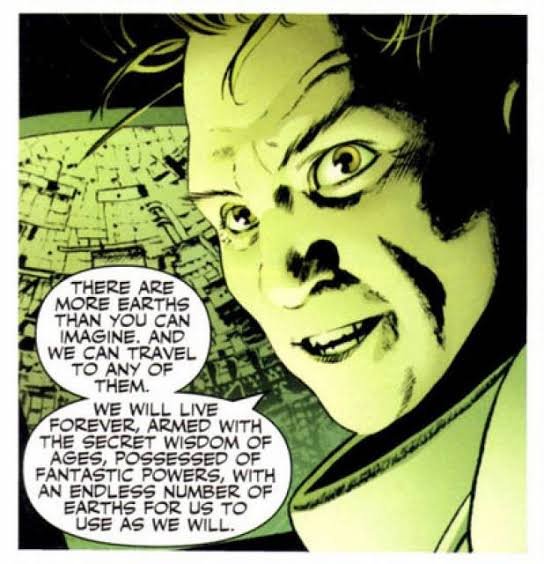
Dowling is Mr Ellis’ interpretation of Marvel Comics’ Reed Richards (Mr Fantastic of the Fantastic Four), albeit one perverted and twisted by his ego and amorality. Dowling sold out humanity to an alien intelligence, and was a devotee of genocide, torture, and assassination. That transaction is what makes Dowling especially sinister: the commercial exchange for knowledge and technology whereby the consideration was the delivery of the Earth and its population to inhuman interests. It is the ultimate deal with the devil.
(Dowling was eventually killed by Elijah Snow, the founder of the Planetary Organisation and, it seems, a part of the Earth’s autoimmune system which reacts to critical threats. Dowling fell to his death from a great height, and his broken body was then dumped by Snow on the bleak plains of the cybernetic Earth as a warning. A pleasing end to a despicable character.)
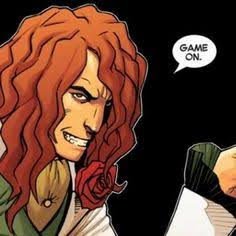
3. Arcade – Avengers: Arena #1-6, 2012-3, Marvel Comics.
Arcade is a villain used repeatedly by Marvel Comics over many decades as a running joke: a man who puts superheroes into peril through ridiculous games.
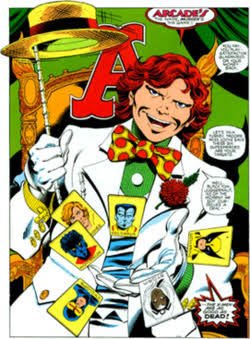
Only once do we see Arcade display some actual utility, when his robot facsimiles of the superhero mutants called the X-Men put the villain Mystique through her paces.

Otherwise, Arcade was a tiresome character from a wackier age of superhero comics.
That changed with the title Avengers Arena, written by an American, Dennis Hopeless. Arcade is depicted in the title as having wallowed in self-pity upon realising that he was regarded as a fool by his super villain peers. Washed up and bullied by a villain called the Constrictor, Arcade had an epiphany upon ensnaring the Constrictor in a goofy trap: he needed to try harder.

Inspired by the book The Hunger Games, which he had read in prison, Arcade built a massive facility in the Antarctic. Arcade then kidnapped sixteen young superheroes from around the world and set them against each other. Nasty manipulation, stress, distrust, and the usual idiocy of high school (which we have considered in our reviews of Deadly Class ) lead the teenagers to start killing and maiming each other in a superhero version of William Golding’s 1954 novel, Lord of the Flies. Arcade is overcome before his objective (a sole survivor) is reached, but escapes, and downloads the video of the harrowing story onto social media.
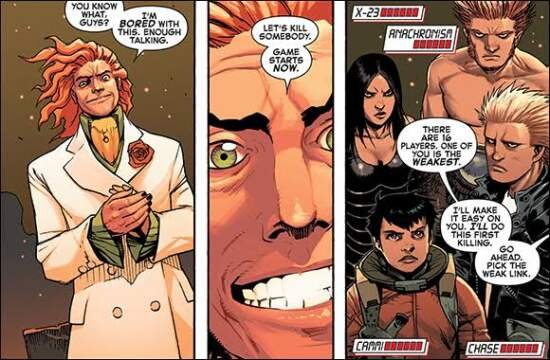
Arcade himself only kills one of the teens, but his mind games make him directly culpable in the grim deaths of another ten youngsters, entirely for perverse self-esteem. Other villains have killed many more, but none have killed teenagers for both sport and self-validation.
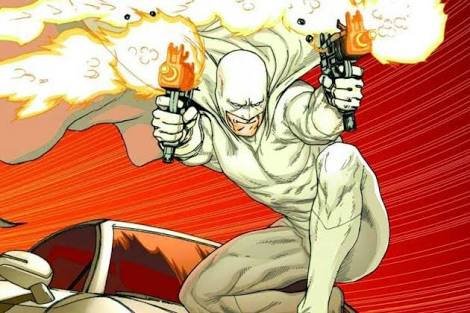
2. Nemesis – Nemesis #1-4, 2010, Icon Comics, 2010.
Created by Mark Millar (as we previously mentioned, a Scot), Nemesis is a white-garbed villain who hunts police chiefs for sport. Nemesis had rampant success in Asia: we are introduced to Nemesis as he murders the Tokyo police chief, using a train full of passengers – and the train then careens into the ground killing all aboard. Nemesis happens also to be a ferocious fighter:

Nemesis decides next to target the police chief of Washington DC, named Blake Morrow. An elaborate series of probability projections by Nemesis has him kidnap the President of the United States, gas the Pentagon thereby killing 20000 people, lands him in prison – only to escape after killing 97 guards, along with every inmate in the prison, and kidnap Morrow’s children and use in vitro fertilisation to impregnate the daughter with his gay son’s sperm.
The climax of the story involves Nemesis giving Morrow a choice: use a remote control to kill Morrow’s wife, or kill the President. Both have bombs strapped to their chests and metres away from Morrow and Nemesis. It evolves the President is a war veteran: he steps towards Nemesis and orders Morrow to detonate the bomb. Morrow thereby kills the President, but also seriously wounds Nemesis, enabling Morrow to engage in an evenly matched hand-to-hand brawl ending when Morrow shoots Nemesis in the head.
It is not just murderous cunning and an enormous body count that puts Nemesis high on our list. The callous viciousness is obviously memorable: it is the glee in perpetrating perversely comped crimes that makes Nemesis thoroughly sinister. But, like Arcade, the motivation of murder as a game brings Nemesis onto our list.

1. Lucifer – Lucifer #1-#75, 2001-2009, Vertigo Comics.
Created by Neil Gaiman (an Englishman) and then significantly refined by Mike Carey (another Englishman), Lucifer is the Devil. But this is no angry red demon with brimestone and a pitchfork: this is the second most powerful entity in the universe, with unparalleled cunning and arrogance, the ultimate embodiment of willpower. Here, temporarily set back by a coalition of vengeful Japanese gods and ancient demons, Lucifer stares down Death:


Lucifer otherwise, in an existential snarl, jeopardises the universe by incinerating pages of the Book of Destiny – a text which spells out the history of time. Lucifer does this so that the embodiment of Destiny cannot see the future, just like everyone else. Lucifer fails in that, but it is an act with overwhelming disregard of the consequences.
The retired king of hell also extinguishes the lives of hundreds of people in Beijing as a tripwire against a threat to his existence. And then he kills billions of beings as he entered the strange dimension known as the Mansions of the Silence, the ephemeral structure of the place unable to cope with the sheer presence of Lucifer’s inherent power. These billions are collateral damage, each taken life insignificant to Lucifer’s plans.
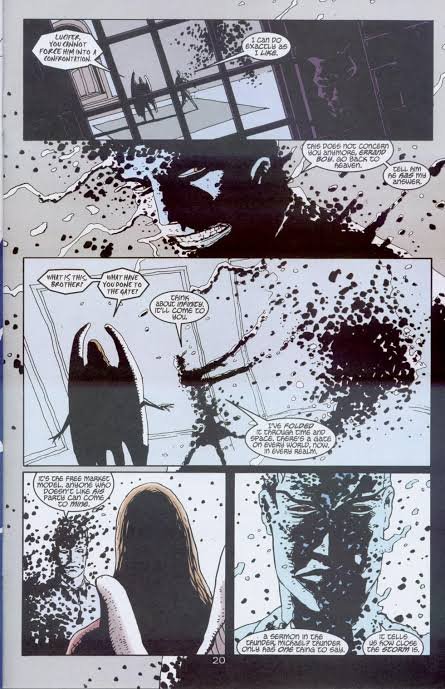
Lucifer has been complicated even in the Bible, and this comic book version is lauded by his fans as a champion of free will. Lucifer #20 (2000), entitled “The Thunder Sermon”, sees two teenagers break into Lucifer’s Los Angeles residence. They become lost within the labyrinth without food or water, and pray to God for relief from their peril. Lucifer walks by: his appearance is entirely sinister.
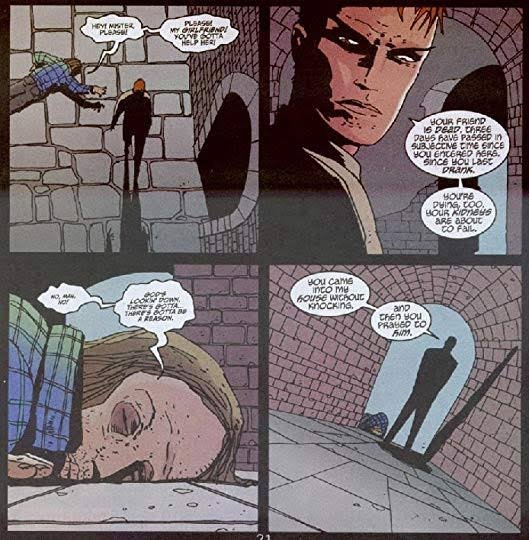
This sequence, allowing the two young people to die because they prayed to God to be saved while in Lucifer’s house, demonstrates how trivial the character can be. It was, obviously, well-within Lucifer’s power to both know of the teens’ presence and to save them. Instead, he allows them both to die miserably and only stops briefly to say why.
This is a master stroke of characterisation by Mr Carey. How can such an almost omnipotent being carry such spite? It would be one thing to punish them for trespassing. It is another to allow two people to die because they prayed to God for survival. Lucifer in that instant demonstrated that he was more than just arrogant, coldly rebellious, and murderous. He was also fundamentally petty. For all of his grand words and noble cause in rejecting predestination and waving the flag for an alternative to God’s plan, Lucifer is incapable of rising above pique. This makes him something other than an anti-hero. It makes the being who lit the stars during Creation, when his powers and fist-shaking are stripped away, miserable and pathetic. For this reason, Lucifer tops our list.

